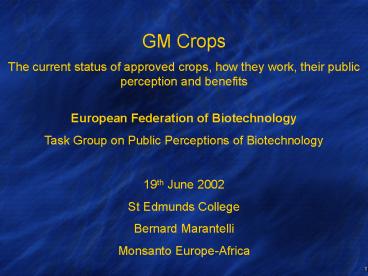Introduction Monsanto RTF EVP PowerPoint PPT Presentation
1 / 18
Title: Introduction Monsanto RTF EVP
1
GM Crops The current status of approved crops,
how they work, their public perception and
benefits European Federation of
Biotechnology Task Group on Public Perceptions of
Biotechnology 19th June 2002 St Edmunds
College Bernard Marantelli Monsanto Europe-Africa
2
Biotechnology builds on centuries of science
6000BC Fermented Beverages Leavening of Bread
Biotechnology is a collection of scientific tools
used to enhance plants, animals, and
microorganisms for the benefit of humans.
1800s Mendels Pea, Darwins Species,
Pasteurs Microbes
1900-1950 Antibiotic Microbes, Plant Breeding
1950-1980 Watson Crick, Gene Sequencing
Green Revolution
1980 2000 Biotech Crops Human Insulin
2001 Human Genome Golden Rice
Photo credit AAAS, ARS, Nature
3
Genomics from chromosomes to genes to proteins
to new products
With application to
- Pharmaceuticals
- Agriculture
- Food Nutrition
- Industrial Processes
- Anthropology
- Bioremediation
- Biofuels
- Genetic information doubling every 2 years.
- Human plant genomes sequenced ahead of
schedule. - Within 5 yrs, most genes will be identified and
understood.
Courtesy of DOE Human Genome Project
4
Drivers facing global agriculture supply
Billions
8
- Challenge
- World population growth 1.1 /yr
- Demand growth 1.4 to 1.6 /yr
- Developing countries desire convenience, taste
health - Developing countries fighting malnutrition
World population
6
Population developing countries
4
- Constraints
- Limited land available for cultivation
- Depleted natural resources
- Declining productivity (3 annual yield gain
during 1970s vs. 1 during 1990)
Agricultural land (ha)
2
Population industrialized countries
0
Biotechnology is part of the solution
Source USDA/ ESR
5
mEPSPS-CTP
degradation
chloroplast
mEPSPS CTP
Phosphoenol pyruvate
X
Aromatic amino acids
EPSP Pi
Shikimate-3 -phosphate
EPSPS
sugars
glyphosate
6
Herbicide Tolerant Sugar Beet Potential for
reduction in herbicide use (kgs) - at 100
adoption (reality may be less)
Belgium
Germany
UK
Spain
France
Holland
Mean
7
Mechanism of Toxicity of Bt Insect Control
Protein..
8
Bt Cotton in China
9
Bt Cotton in South Africa
- First season, average yield increase 18
- Second season, yield increase up to 60
- Yield difference was probably related to
unusually heavy rainfall - Average pesticide cost reduction first season was
13 and 38 the second season
10
Who benefits from BT Cotton?
13M
Seed Companies
5
22M
Consumer
9
50M
Technology Inventor
21
141M
Farmer
59
240M
Total Benefits
100
0 50 100 150 200
250
BENEFITS IN MILLION
SOURCE Traxler Falck-Zepada, Ag Bioforum
2(2), 1999 at www.agbioforum.missouri.edu
11
Future Trends in Pesticide Use In Corn, Soy
and Cotton
By the year 2009, biotech based row crops will
be responsible for a 19 million lb reduction in
insecticides and a 68 million lb reduction in
herbicide use.
304
22
236
Million lb per year
28
66
9
1997 2009 1997 2009
Herbicide Use Insecticide Use
Source Kline Co. 2000. Plant Biotech
Impact. Business Analysis 2009 Data pertaining to
the US
12
In any country, less than 20 volunteer GMfoods
as greatest threat to food safety
Say GM foods greatest food safety threat
- Voluntary mentions of GM foods as the greatest
food safety threat have declined in both France
and Great Britain, suggesting concerns about GM
foods are becoming less top-of-mind in these
strongly opposed countries. - However, this trend is reversed in Japan and
Mexico. - Americans and Brazilians are the least likely
countries to say GM is the greatest food safety
threat.
Q What, if anything, do you feel are the greatest
threats to the safety of the food you eat?
Unprompted, up to 3 mentions
13
Less than 5 worldwide avoid GM foods (unprompted)
8-Nation Average Avoiding
- Less than 1 in 20 have top-of-mind mentions of
avoiding GM foods. - Consumers worldwide much more likely to mention a
number of other food ingredients, especially meat
or high-fat foods.
Q Over the past year, what if anything have you
been avoiding or eating less of? Unprompted, up
to 3 mentions
new precode for 2001
14
International Service for the Acquisition of
Agri-biotech Applications
Global plantings of GM crops (hectares). ISAAA
Press Release October 18, 2001
- Growth continues globally in the plantings of GM
crops. - Growers and society are offered more efficient
and higher crop productivity that helps towards a
more sustainable agriculture. - Experience is from 15 countries including
Argentina, Australia, Canada, China, South Africa
and the USA.
15
International Service for the Acquisition of
Agri-biotech Applications
Global plantings of GM crops (hectares) By
Country ISAAA Report 21-2000 published 2000
- The EU which imports much feedstock from the rest
of the world is consuming these products. - The EU as a generator of revenue from such crops
is a minor player. - These other countries are reaping the benefits of
higher crop yields, lower chemical use, higher
quality (lower crop and grain damage and lower
foreign material) and lower costs of production. - China is rapidly catching up as a player.
16
Global Biotechnology Regulatory Activity
Life sciences biotechnology have entered a
stage of exponential growth, opening up a vast
potential to move economics in Europe and
globally towards more sustainable development and
improved quality of life Europe cannot afford
to miss the opportunity that these new sciences
and technology offer Commission of the European
Communities, Sept. 2001
- Actively granting approvals
- Pre-Commercial field trials
- Commercialization delayed
17
Sustainable development
Projects partnerships to increase the impact of
what we do
18
Benefits to farmer, improved productivity
gt 95 of Customers Satisfied
- Increase grain fiber yield (quality)
- Decreased operating costs (economics)
- Enhanced water conservation (contill)
- Reduced soil erosion (2 tons/year/acre)
- Decreased pesticide spraying (exposure)
- Additional Net Return/Ha
- HT SOY 30
- HT CANOLA 39
- BT CORN 67
- BT COTTON 133
- Source
- CLIVE JAMES, GLOBAL REVIEW OF COMMERCIALIZED
TRANSGENIC CROPS - Moschini, et al., (Sept. 1999) Iowa Agriculture
and Home Economics Experiment Station

